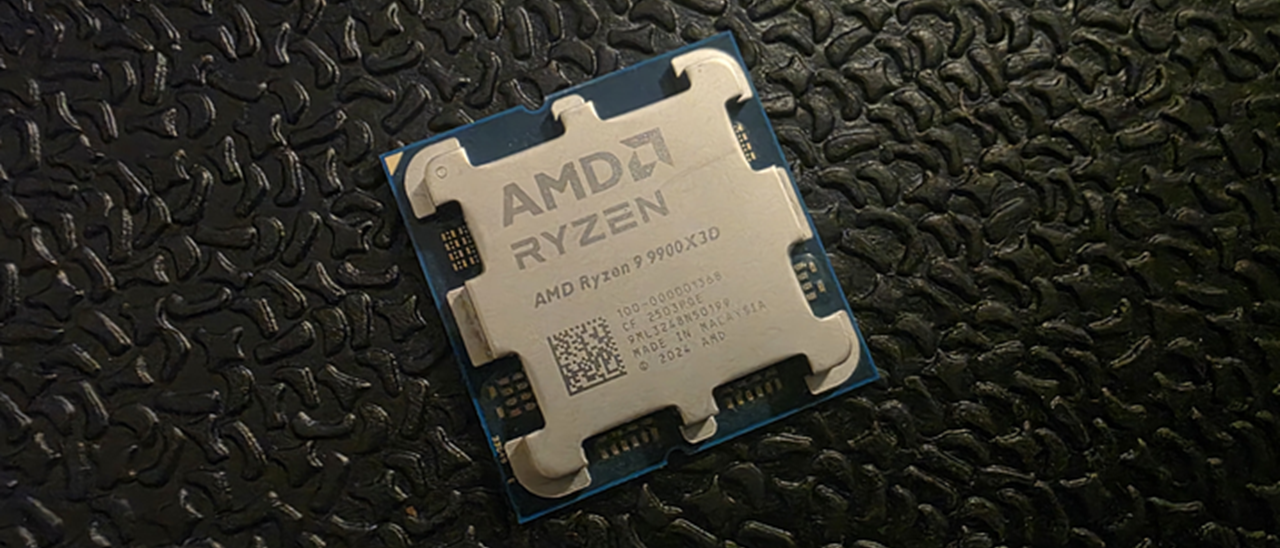Why you can trust Tom's Hardware
AMD Ryzen 9 9900X3D Power Consumption and Efficiency
We measure CPU power consumption metrics directly at the EPS12V connector because software-based measurements can be 'cheated' by motherboard vendors. This approach gives us the best visibility into accurate power consumption metrics but differs from results gathered from the wall plug (which include full system power) and software-based measurements. Our measurements represent the power the CPU power delivery subsystem consumes directly from the PSU, but it doesn't account for VRM efficiencies (roughly 10% on high-end motherboards).
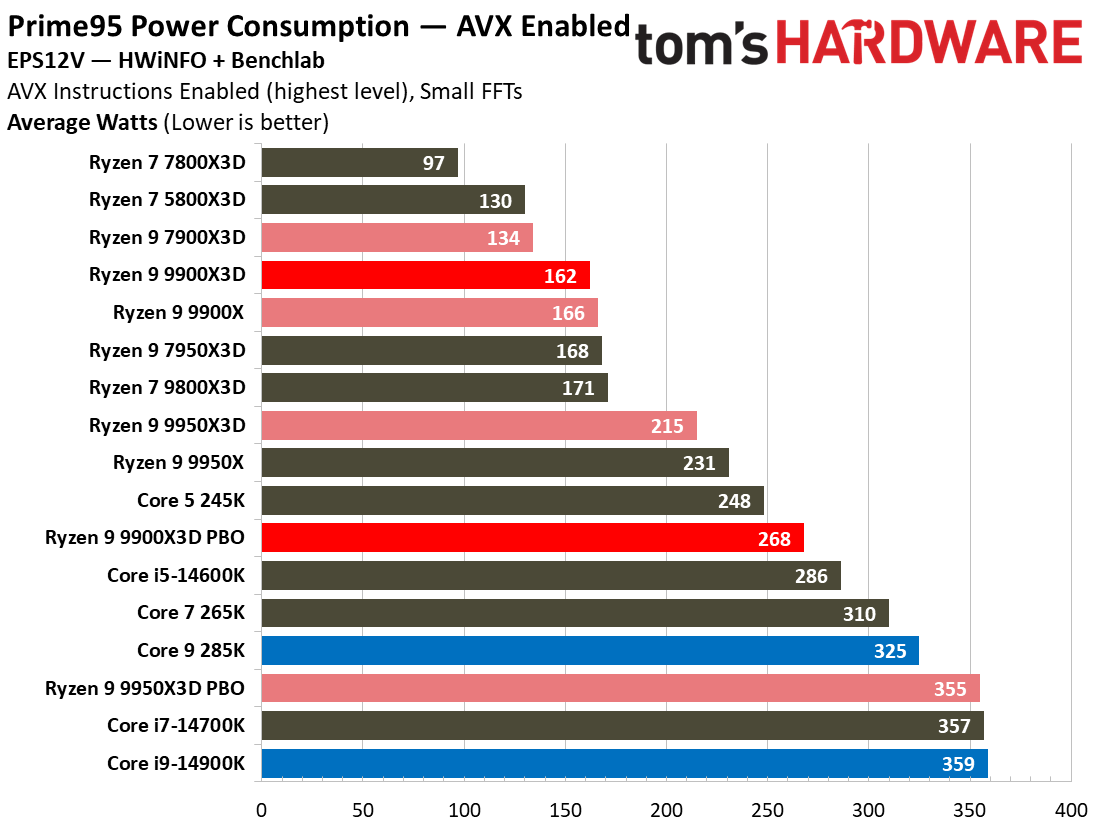
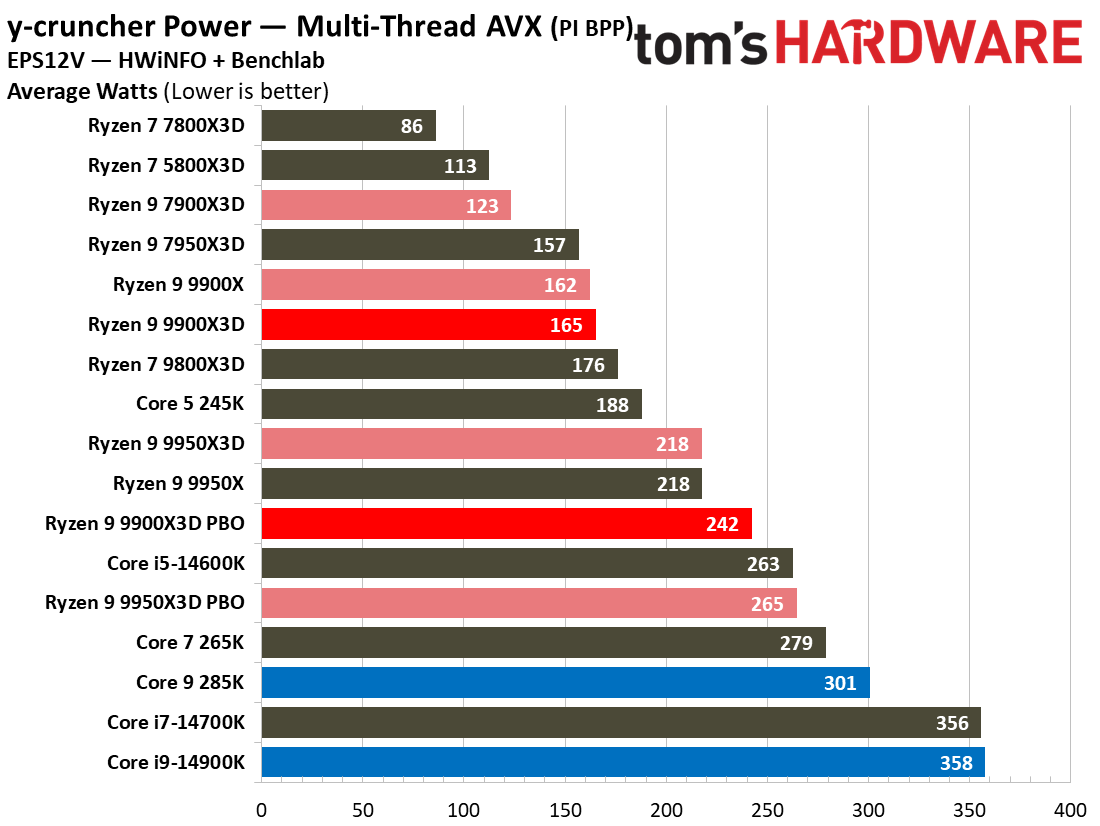
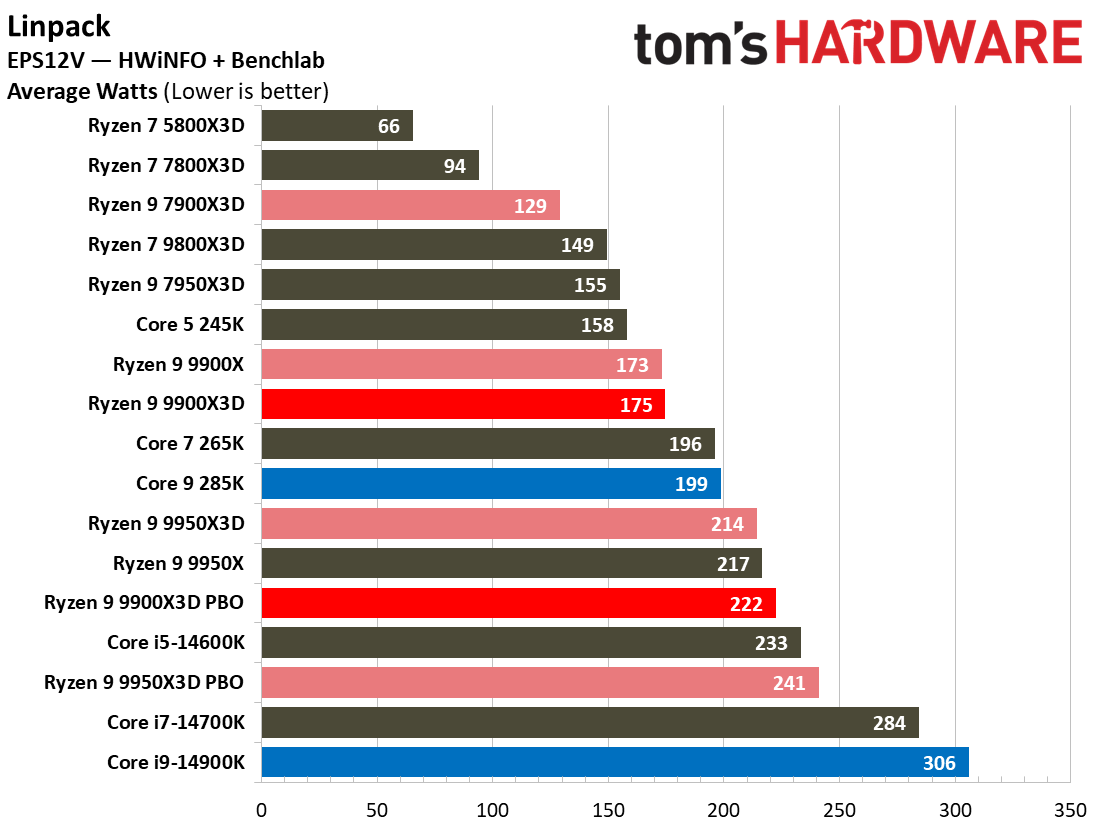
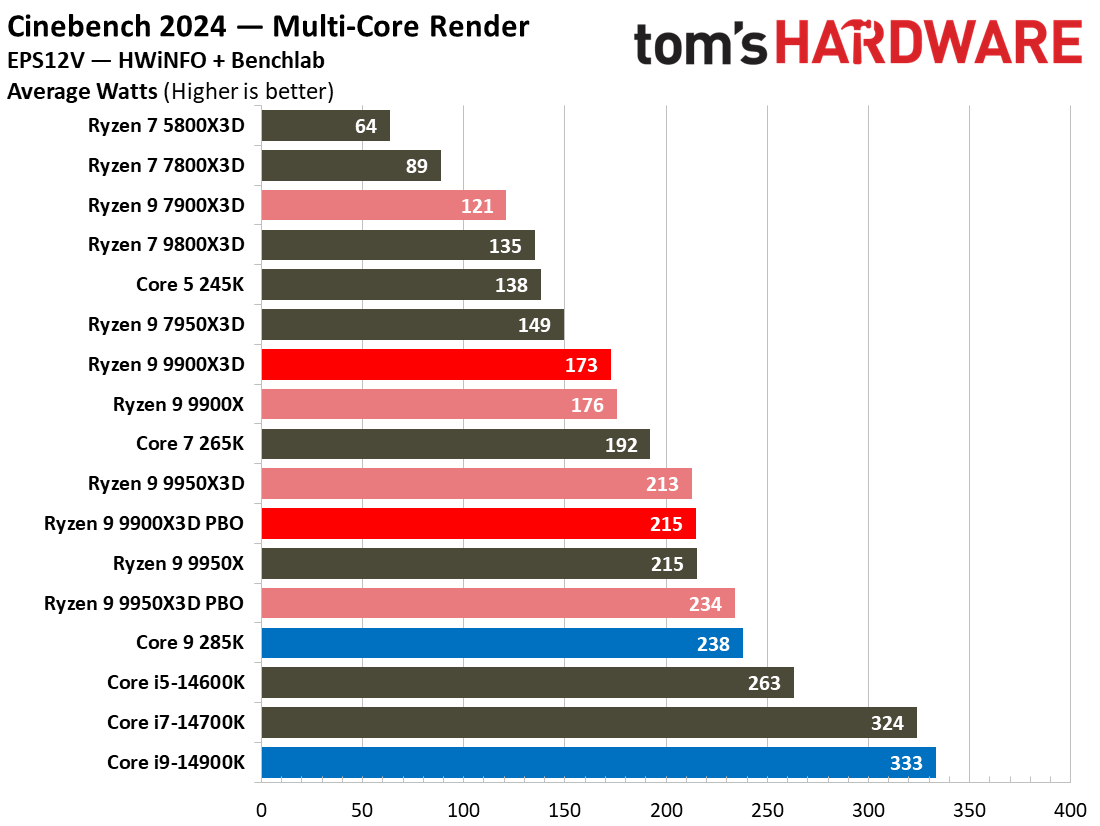
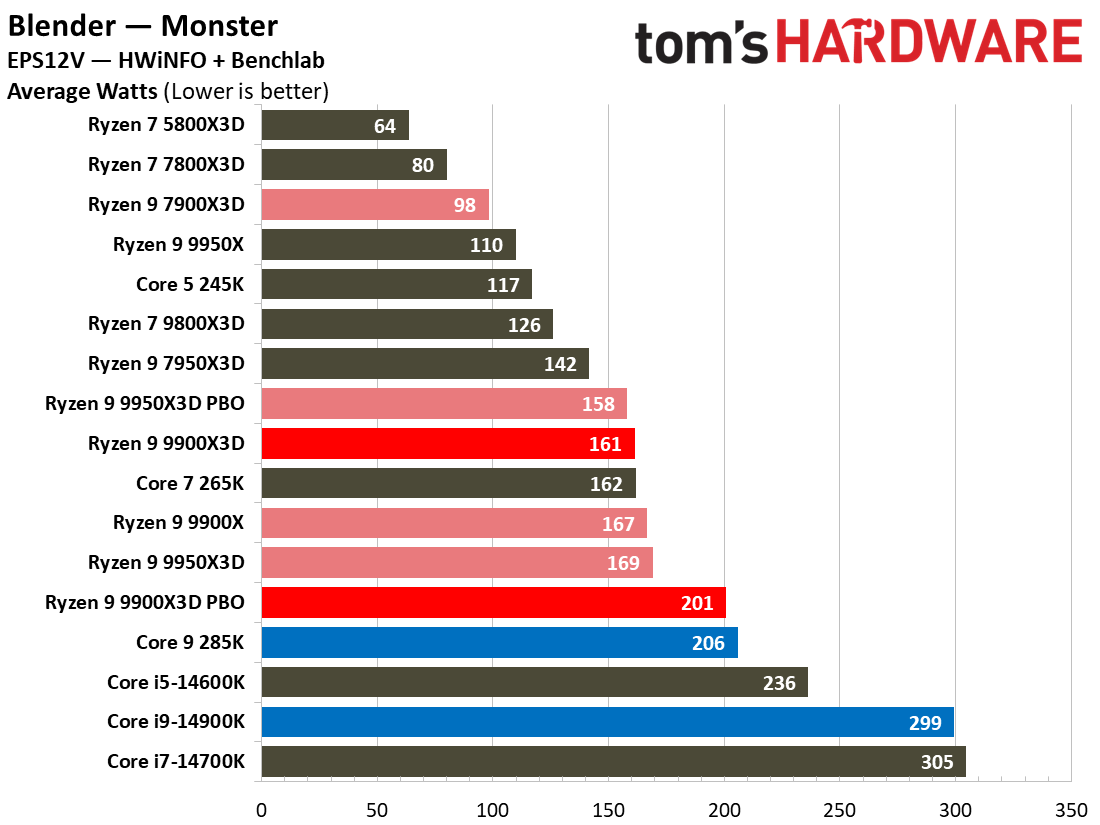


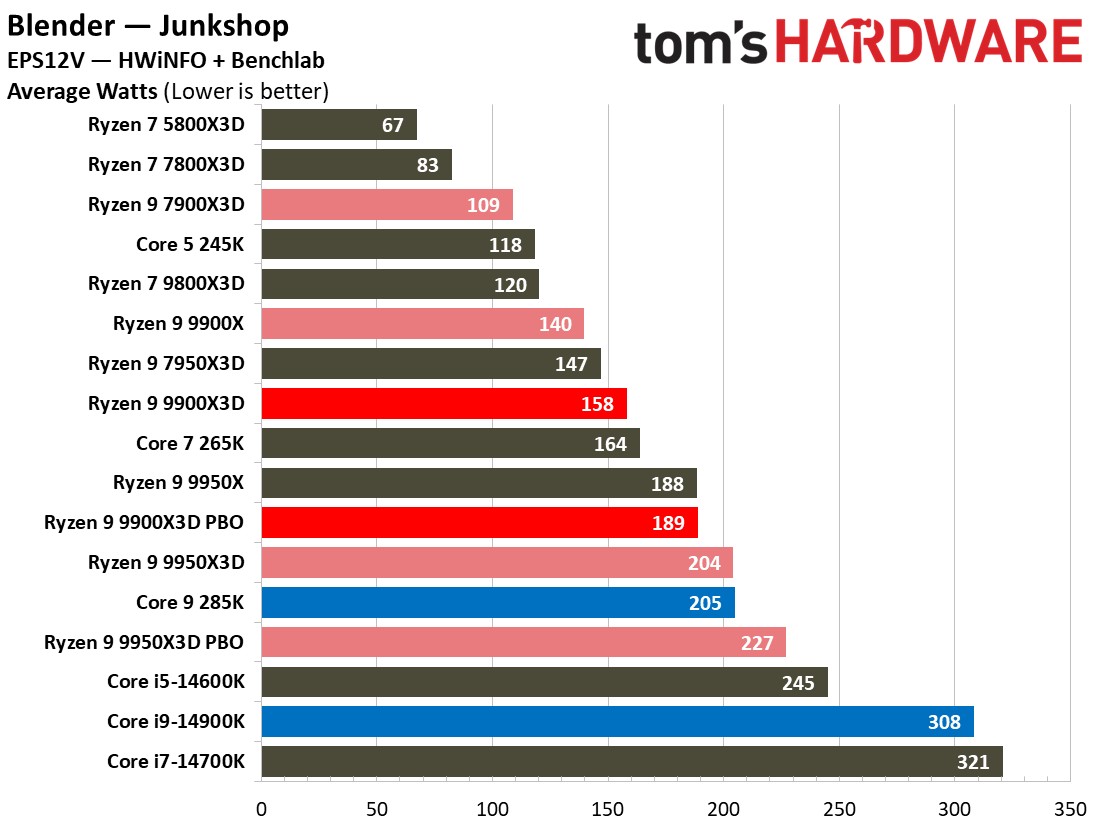
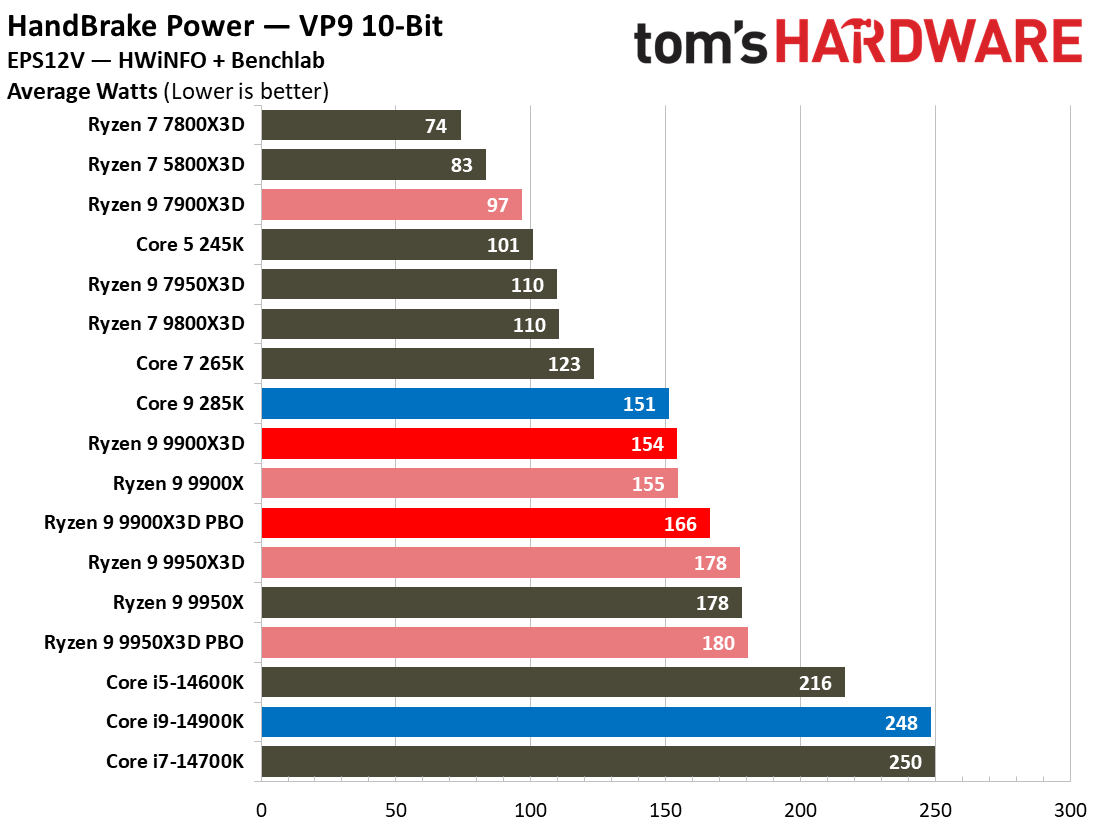
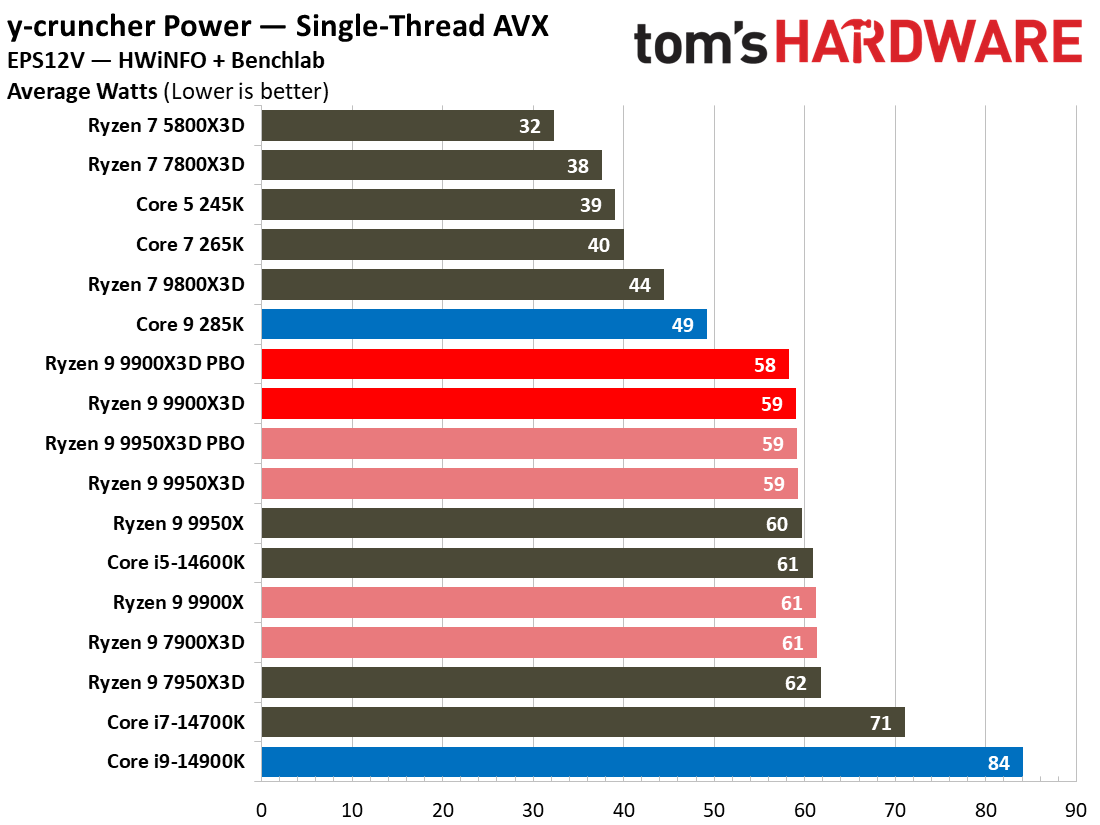
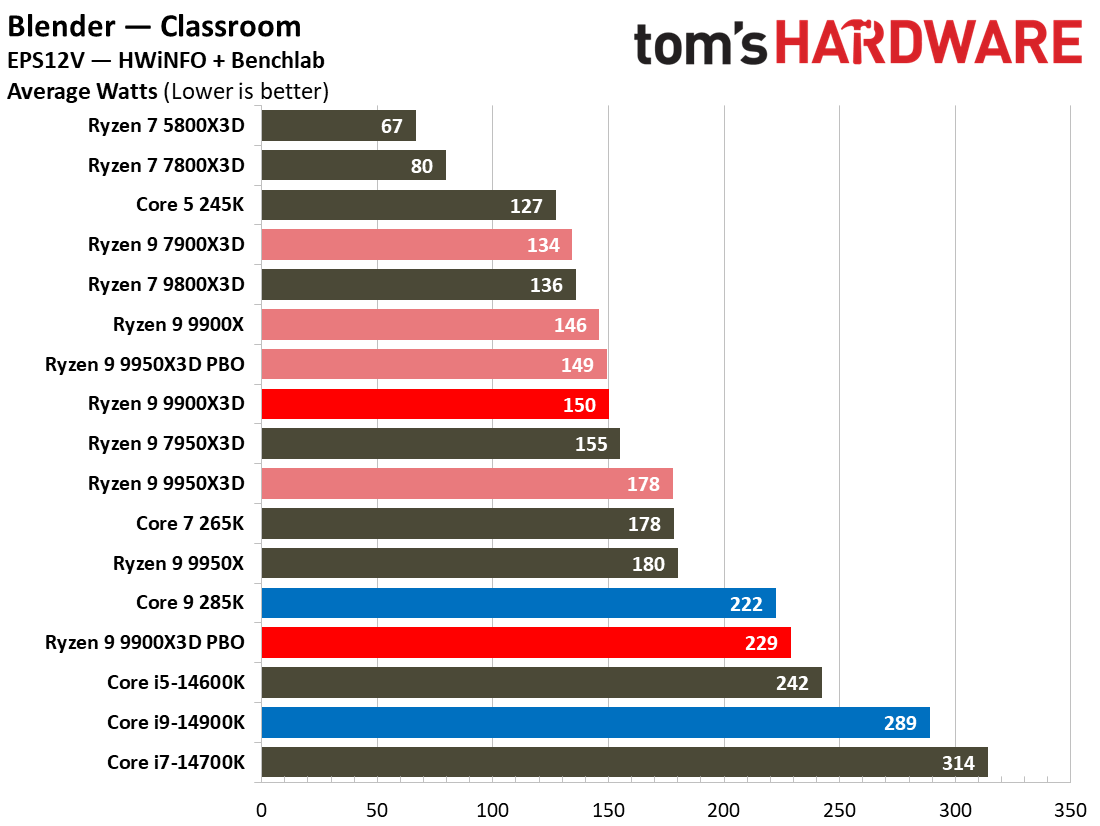
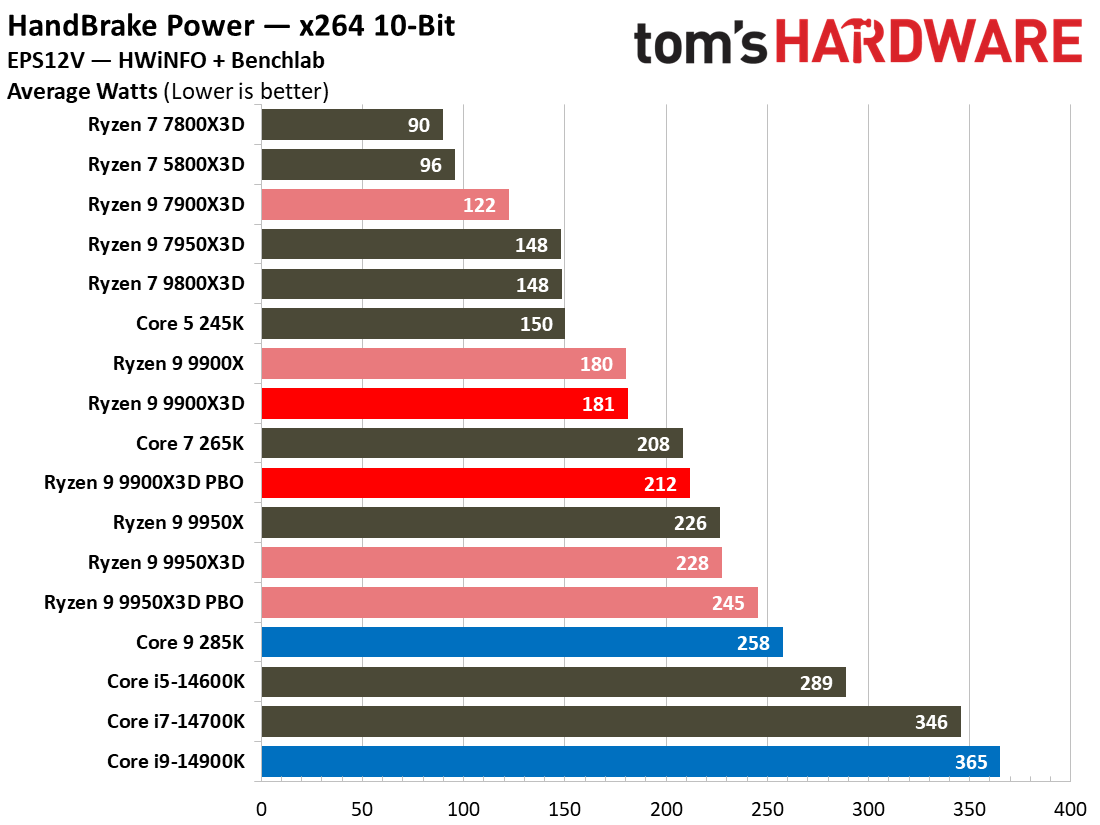
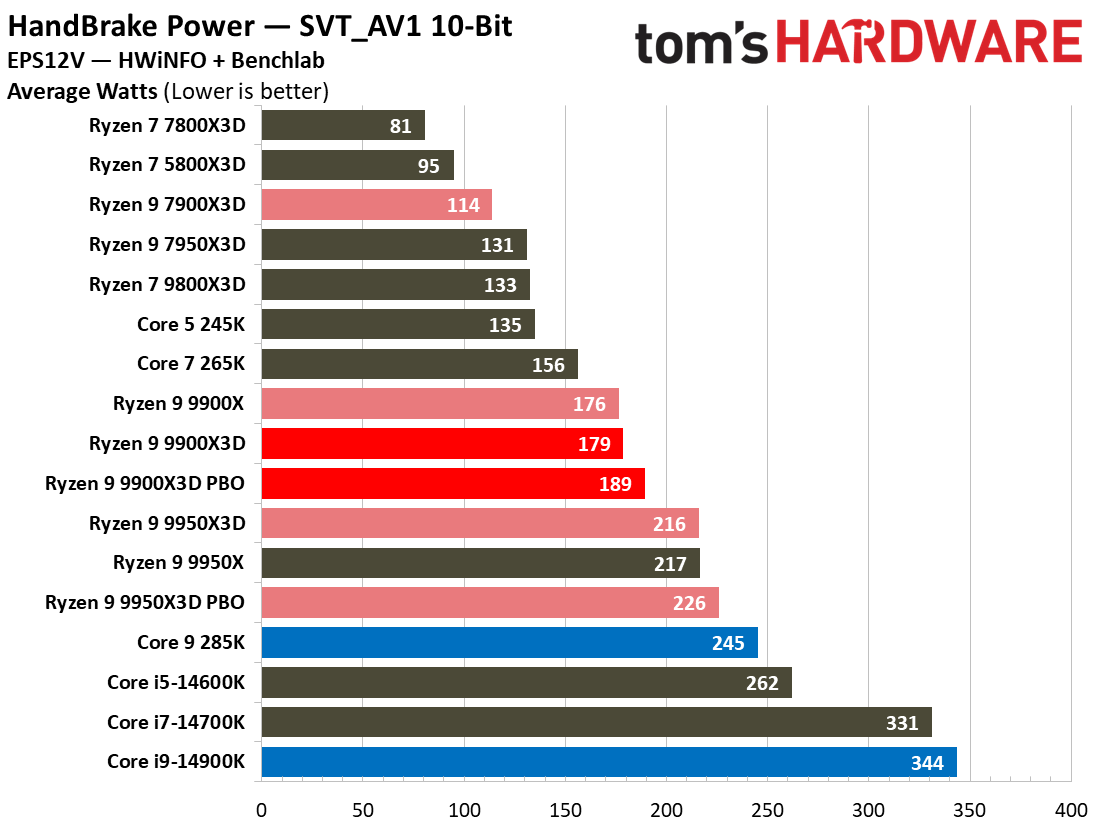
The Ryzen 9 9900X3D isn't as power hungry as its larger sibling, the 9950X3D. The chip peaked at 181W but hovered in the 160–170 Watts range during many of the workloads.
As expected, the Core i9-14900K is an egregious power guzzler, sucking down up to 383W during the Blender workload, but it does deliver more overall performance in our suite. The Core Ultra 9 285K is more miserly than the 14900K, but it peaks at 325W, showing it can also have a voracious appetite.
As expected, we see a disproportionately large increase in power consumption for slim performance gains when we kick on the 9900X3D’s Precision Boost Overdrive (PBO) feature. PBO isn’t worth the extra power consumption for gaming, where it delivers imperceptible benefits, but it's far more useful for those focused on productivity work or heavy multi-tasking.
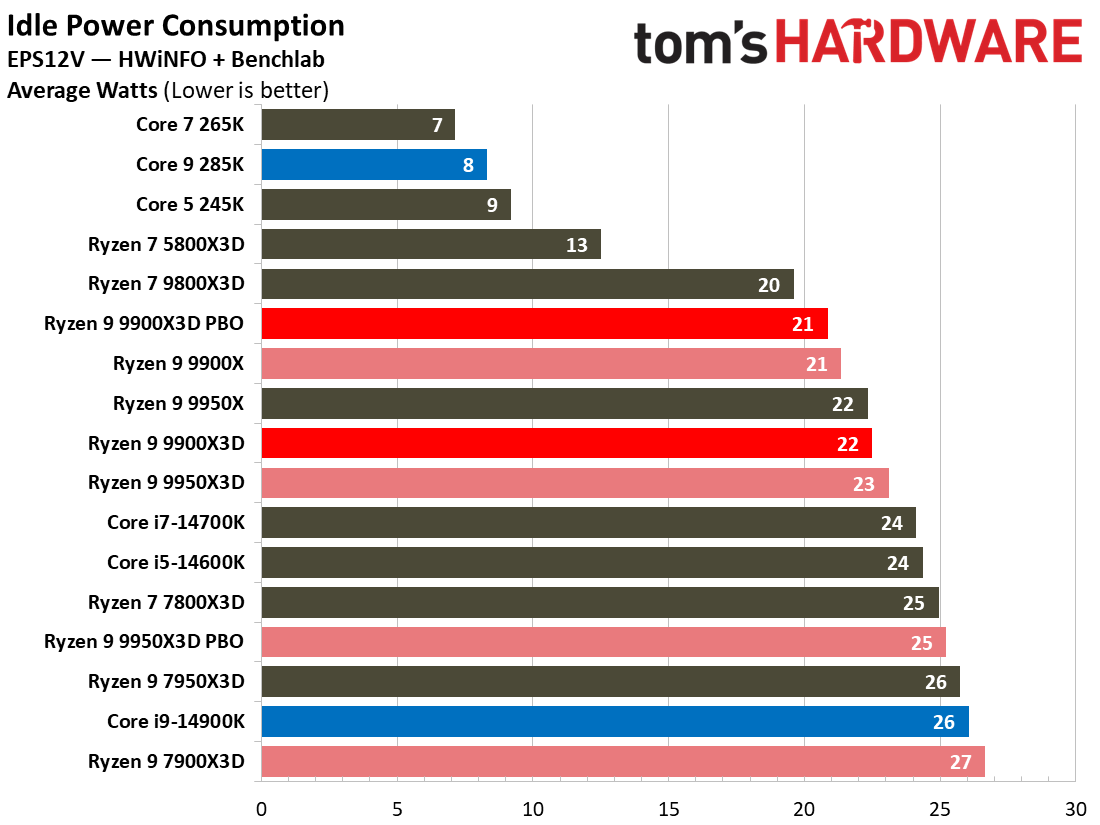
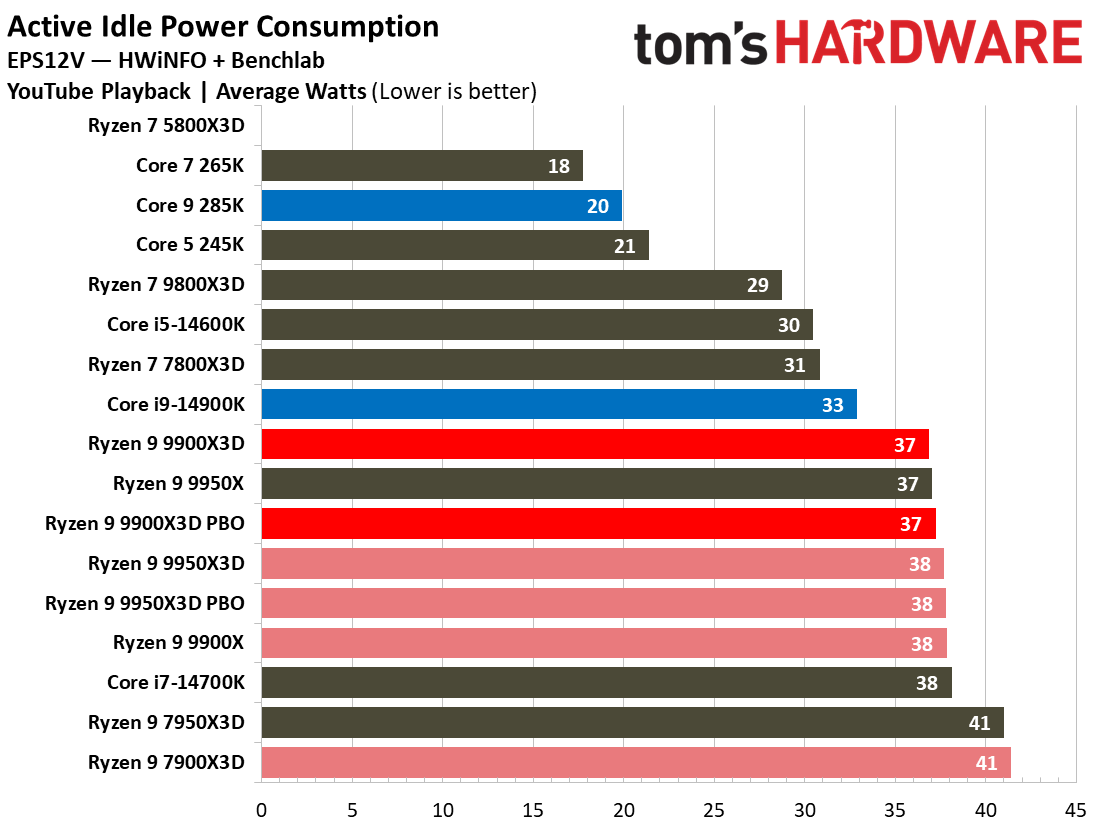
We measure our standard idle power metrics after a lengthy time of inactivity with all background tasks terminated. The Ryzen processors consume more idle power than comparable Intel models, largely due to the need to keep the large I/O Die powered despite low-load conditions. Here, the Core Ultra processors bring idle power consumption to new lows, with the 285K consuming only 8W. In contrast, the Ryzen 9 9900X3D pulls 22W at idle, a notable disadvantage.
Most PCs rarely truly idle; users might leave various applications open on the desktop. There's also an 'active idle' use case wherein the user does a low-load activity, such as browsing the web or watching a YouTube video. To model this behavior, we created an active idle test (second slide) with two browser windows open (one with two tabs idling on a website and another window with a 4K YouTube video stream playing). We measure this level of activity across a 15-minute timespan.
We measured the Core Ultra 9 285K at 20W under these conditions, but the Ryzen 9 9900X3D consumed 37W. While we can see that the 9900X3D has improved compared to the previous-gen Ryzen 7000X3D models, this is still a significantly higher amount of active idle power draw than the Intel chips.
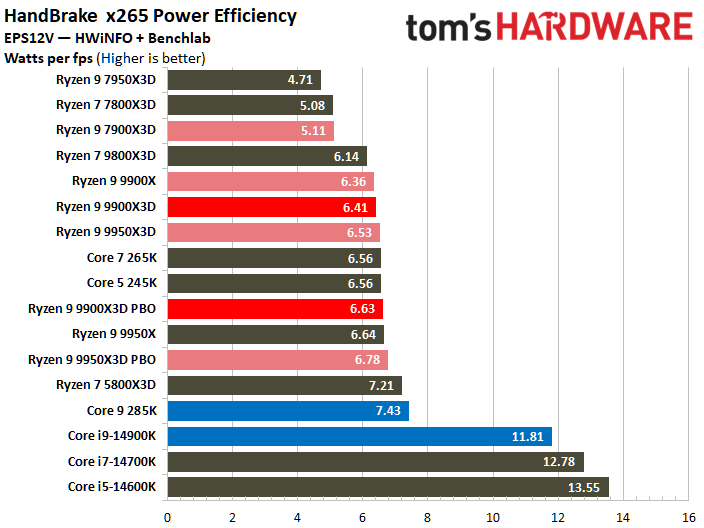

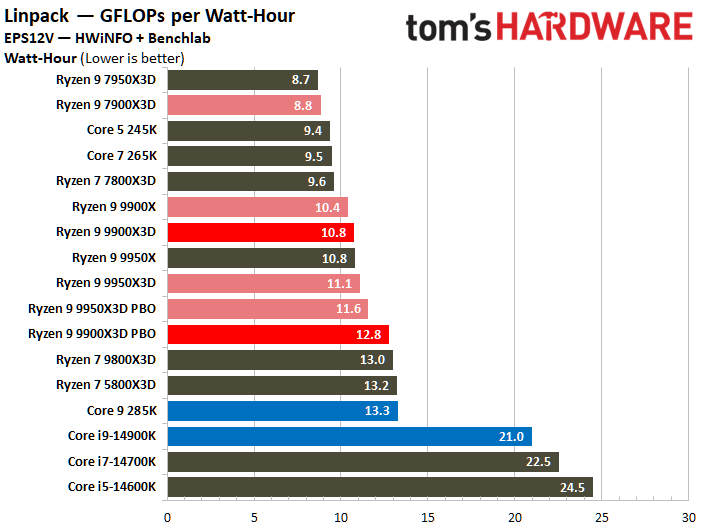
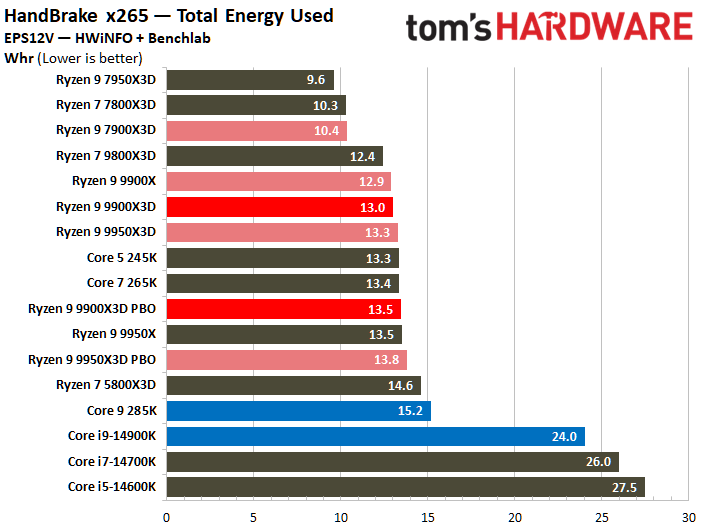
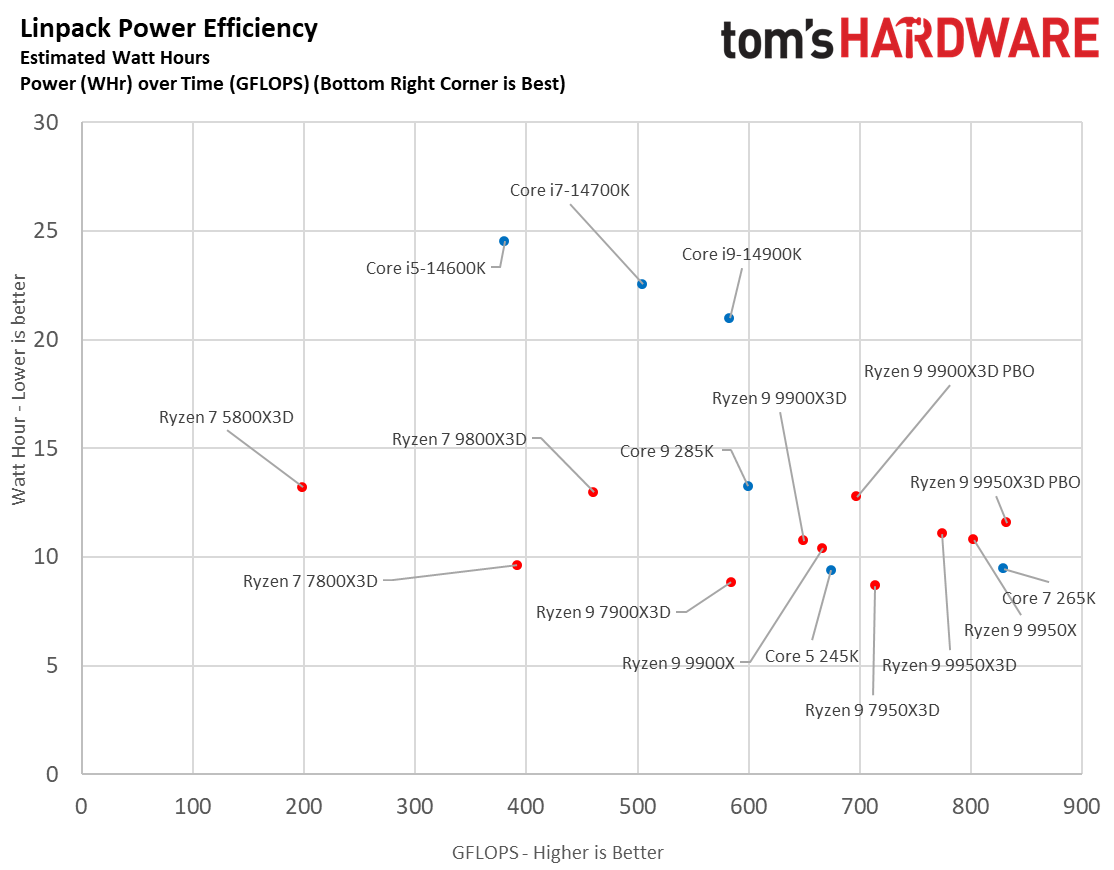
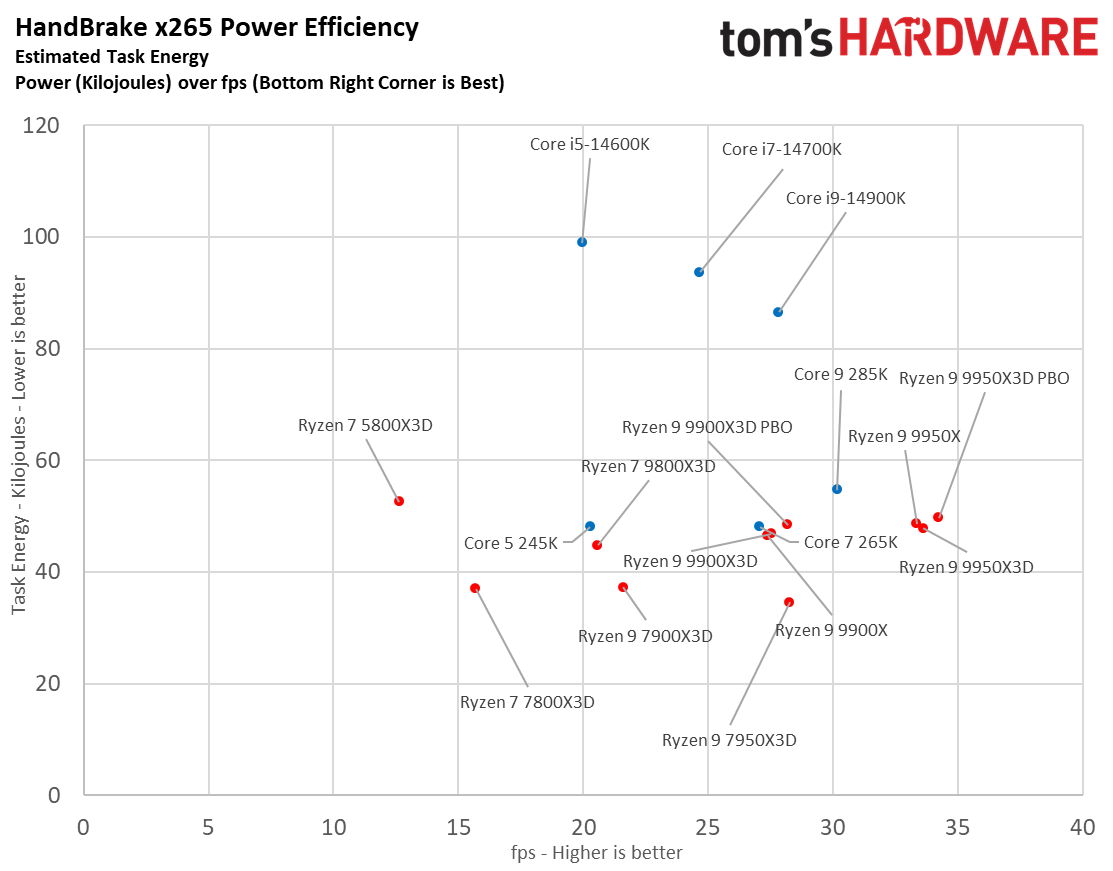
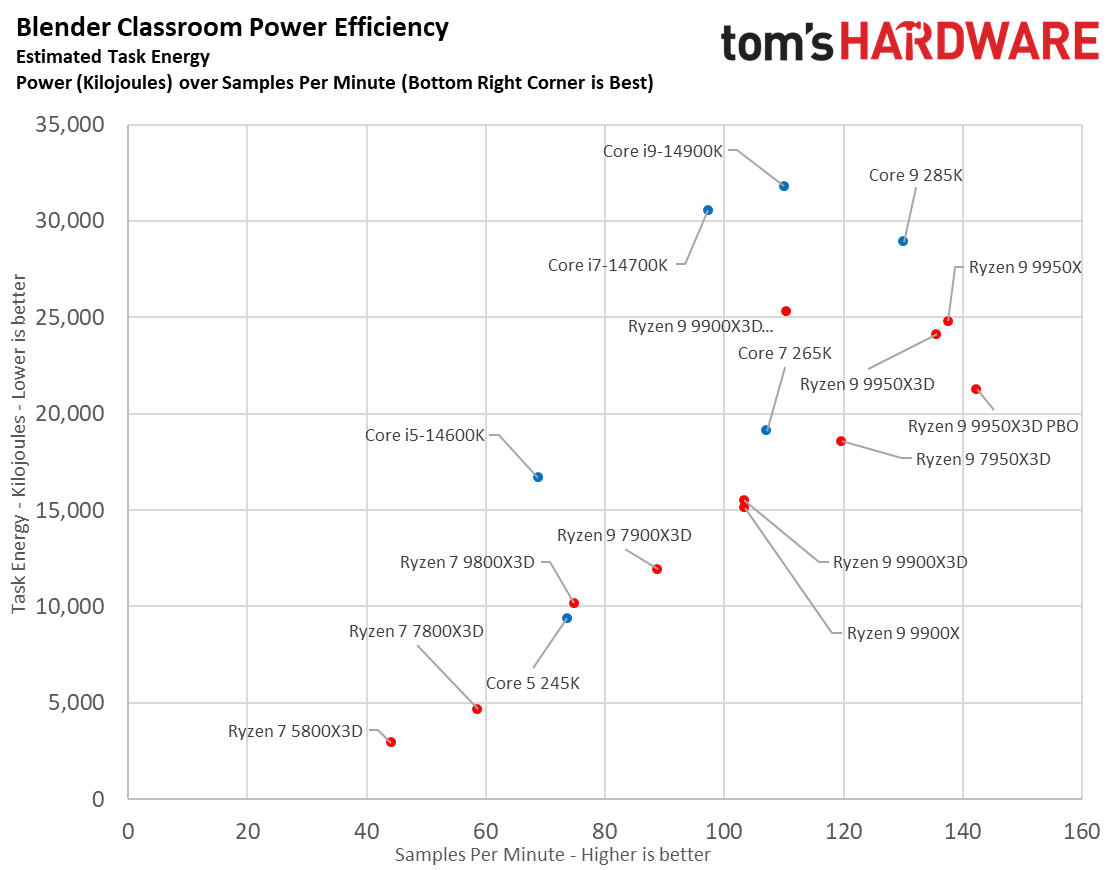
The watts-per-FPS chart quantifies power efficiency during an x265 HandBrake workload. The 9900X3D is near the top of the list with strong power efficiency metrics. We see a similar trend in the other efficiency metrics.
The last three slides take a slightly different look at power consumption by plotting the cumulative energy required for an x265 HandBrake, Linpack, and Blender workload. We plot this 'task energy' value in Kilojoules on the left side of the chart, with performance charted on the x-axis.
These workloads consist of a fixed amount of work, so we can plot the task energy against the performance during the job (bottom axis), thus generating a useful power chart. Faster compute performance and lower task energy are ideal. That means processors closest to the bottom right corner of the chart are the best.
The Ryzen 9 9900X3D falls into the sweet spot of performance and power efficiency in these charts, with a particularly strong showing in Blender. Meanwhile, the 285K and other Arrow Lake chips greatly improve over their 14th-Gen predecessors.
AMD Ryzen 9 9900X3D Test Setup
We tested with the latest version of Microsoft Windows 24H2 (22631) and have updated all drivers, BIOSes, and applications to the latest versions. To speed up the testing process, we use XMP/EXPO as the default memory profile for all tested configurations. The memory speeds used for each chip are shown in the table below.
We tested the Ryzen 9 9900X3D in standard stock trim and with the auto-overclocking Precision Boost Overdrive (PBO) feature enabled. We used the 'advanced' and 'motherboard' power settings for the PBO configuration with a 10X scalar and 200 MHz clock adjustment. We also dialed in a -15 all-core Curve Optimizer offset.
We used lifted power limits for the Intel processors, which results in higher power consumption and heat, but you get faster performance in exchange.
We use the Nvidia GeForce RTX 5090 Founders Edition for our game testing. For the sake of expediency, our power measurements in the gaming section are gathered by polling the motherboard sensor loop, while the metrics in the dedicated power testing section use more precise direct measurements at the EPS12V connector.
Microsoft has advised gamers to turn off several security features to boost gaming performance. For maximum performance, we disabled Virtualization Based Security (VBS) on all systems. Be aware that, due to hardware acceleration, some processor architectures handle virtualization better than others. This can provide a performance advantage when gaming with VBS enabled, but we haven't observed meaningful differences in our testing.
Intel Socket 1851 (Z890) | Core Ultra 9 285K, Ultra 7 265K, Ultra 5 245K |
Motherboard | MSI Z890 Ace |
RAM | 32GB G.Skill Trident Z5 RGB DDR5-7200 |
Intel Socket 1700 DDR5 (Z790) | Core i9-14900K, i7-14700K, Core i5-14600K |
Motherboard | MSI Z790 Carbon Wifi |
RAM | 32GB G.Skill Trident Z5 RGB DDR5-7200 |
AMD Socket AM5 (X670E) | Ryzen 9 9900X3D, Ryzen 9 9950X3D, Ryzen 7 9800X3D, Ryzen 9 9900X, Ryzen 9 9950X, Ryzen 7 7800X3D, Ryzen 9 7900X3D, Ryzen 9 7950X3D |
Motherboard | MSI MPG X870E Carbon WiFi |
RAM | 32GB G.Skill Trident Z5 Neo DDR5-6000 |
AMD Socket AM4 (X570) | Ryzen 7 5800X3D |
Motherboard | MSI MEG X570 Godlike |
RAM | 2x 8GB G.Skill Trident Z Royal DDR4-3600 |
All Systems | 2TB Sabrent Rocket 4 Plus, Silverstone ST1100-TI, Open Benchtable, Arctic MX-4 TIM, Windows 11 Pro |
Gaming GPU | Nvidia RTX 5090 FE |
Application GPUs | Nvidia GeForce RTX 2080 Ti FE |
Cooling | Corsair iCue Link H150i RGB |
Note: | Microsoft advises gamers to disable several security features to boost gaming performance. As such, we disabled secure boot, virtualization support, and fTPM/PTT. |
- MORE: Best CPU for gaming
- MORE: CPU Benchmark Hierarchy
- MORE: Intel vs AMD
- MORE: How to Overclock a CPU
Get Tom's Hardware's best news and in-depth reviews, straight to your inbox.
Current page: AMD Ryzen 9 9900X3D Power Consumption, Efficiency, Test Setup
Prev Page Ryzen 9 9900X3D SPECworkstation 4 Benchmarks Next Page Ryzen 9 9900X3D — Caught in the Middle
Paul Alcorn is the Editor-in-Chief for Tom's Hardware US. He also writes news and reviews on CPUs, storage, and enterprise hardware.
-
m3city High power usage in iddle, really? One could draw some conclusions based on graphs provided, but definitely not that.Reply -
Neilbob Really not sure why AMD are bothering with the #900 X3D variants. Neither the price or the performance fit, in either direction. Those 6 core chips with the extra cache would be far better diverted to a cheaper #600 X3D if there are enough defective dies to bother, that is.Reply
If it was another 50-75 of your chosen currency cheaper, then it might be more interesting. -
logainofhades I agree that they should just sell these dies as a 9600x3d, and skip the 9900x3d altogether.Reply -
Heat_Fan89 From reading and hearing several reviews (Gamers Nexus), i'm surprised that the 9950X3D and 9900X3D did not demolish the lesser and older 9800X3D. In fact Steve Burke from GN, said the 9950X3D was on par with the 9900X3D and 9800X3D. I decided for my gaming build to go with the 9800X3D, not because of price but the 9800 was the choice for a gaming rig. I recently snagged a new 9800X3D on sale from Amazon for $443.Reply -
JarredWaltonGPU Reply
Why not? Are you missing these charts?m3city said:High power usage in idle, really? One could draw some conclusions based on graphs provided, but definitely not that.
https://cdn.mos.cms.futurecdn.net/Wpec6VRKFNm8Yz2XX46WN3.pnghttps://cdn.mos.cms.futurecdn.net/MZ7DJqYn2gNn4vTHK9aWJ3.png
In idle and light workloads, AMD's CPUs are sitting about 14~17 watts higher than the Core Ultra 9 285K. Is that a terrible thing that should prevent people from buying it? No, but it is a weakness of AMD's design right now. It's something AMD should look into addressing with future designs. Because even though it's only 15W or so (that's two 60W LED bulb equivalents), it should be possible to get that power use down.
Imagine a phone or mobile device that used almost 3X more power at idle than the competition. That would be a major concern. And in light workloads like YouTube, if it had to use twice as much power, that would also be bad.
Some people seem to think the pros and cons are us screaming "THESE ARE AMAZING ASPECTS" and "THESE ARE TEH WORST ASPECTS" but they're really just a high-level summary of some key points — things that are going well, things that could be improved (without the shouting).
I'm not sure why anyone would be surprised that, in gaming, the 8-core X3D and the 8-core X3D plus 8-core standard CCDs perform better in games than a 6-core X3D plus 6-core standard configuration. The whole point of the X3D is to shift cache-sensitive workloads to that CCD, away from the other CCD that lacks the extra cache.Heat_Fan89 said:From reading and hearing several reviews (Gamers Nexus), i'm surprised that the 9950X3D and 9900X3D did not demolish the lesser and older 9800X3D. In fact Steve Burke from GN, said the 9950X3D was on par with the 9900X3D and 9800X3D. I decided for my gaming build to go with the 9800X3D, not because of price but the 9800 was the choice for a gaming rig. I recently snagged a new 9800X3D on sale from Amazon for $443.
It's a whitelist software solution (meaning, AMD explicitly lists which games should effectively disable the non-X3D CCD), and not everything benefits. But as we've seen plenty of times in the past, the dual-CCD (and quad-/hex-/octal-CCD Threadripper) solutions add latency to memory and cache transactions and that reduces gaming performance.
In fact, that's precisely the problem Intel has with Arrow Lake: higher memory latency means lower gaming performance. -
usertests Reply
Higher margin on the chip, perhaps? Although the street price is already below MSRP.Neilbob said:Really not sure why AMD are bothering with the #900 X3D variants. Neither the price or the performance fit, in either direction. Those 6 core chips with the extra cache would be far better diverted to a cheaper #600 X3D if there are enough defective dies to bother, that is.
This should be the last hurrah for the awkward AMD 12-cores. Zen 6 will move to 12-core chiplets. The equivalent chip in that lineup might have 16, 18, or 20 cores, a minimum of 8 cores in each CCX. The 3D cache whitelisting problem could persist, but the single-CCD 9800X3D successor will have 12 cores and walk all over the 9900X3D in every scenario. -
Neilbob Reply
Oh, I definitely understand the reason for it, but I like to delude myself in to thinking that AMD would do something 'nice' for us dinky liddle consumers. I know; I may as well wish for world peace, with a mysterious multi-million inheritance thrown in.usertests said:Higher margin on the chip, perhaps? Although the street price is already below MSRP.
Then again, I can't see how a 9600X3D wouldn't sell like hot cakes at 300, or even a bit more. -
usertests Reply
The other reason they are wary of doing a wide, early release of 6-core X3D is because it clearly undercuts the 8-core X3D for the many games that are fine running on 6 fast cores.Neilbob said:Oh, I definitely understand the reason for it, but I like to delude myself in to thinking that AMD would do something 'nice' for us dinky liddle consumers. I know; I may as well wish for world peace, with a mysterious multi-million inheritance thrown in.
Then again, I can't see how a 9600X3D wouldn't sell like hot cakes at 300, or even a bit more.
They could probably get away with charging $350 for a 9600X3D, but if it costs about the same to make as $480+ 9800X3D due to high yields, a chunk of money is left on the table. So it will probably get introduced much later in this generation when enough defective chips are accumulated, following the pattern. -
Albert.Thomas "We measured the Core Ultra 9 285K at 20W under these conditions, but the Ryzen 9 9900X3D consumed 37W. While we can see that the 9900X3D has improved compared to the previous-gen Ryzen 7000X3D models, this is still a significantly higher amount of active idle power draw than the Intel chips."Reply
What about medium-light conditions Paul?
I've been able to pull a (relatively) insane amount of power with the 9950X3D just by spinning my mouse around really quickly.
With the disclaimer that I haven't tested this in detail, it appears that AMD's flagship X3D CPU is much less efficient below 100W, but is more efficient above 100W. -
Notton What AMD really needs is an 8+4, not a 6+6Reply
Although, judging by the amount of binned 4-cores they sell, it seems the yields are so good they have almost none.
